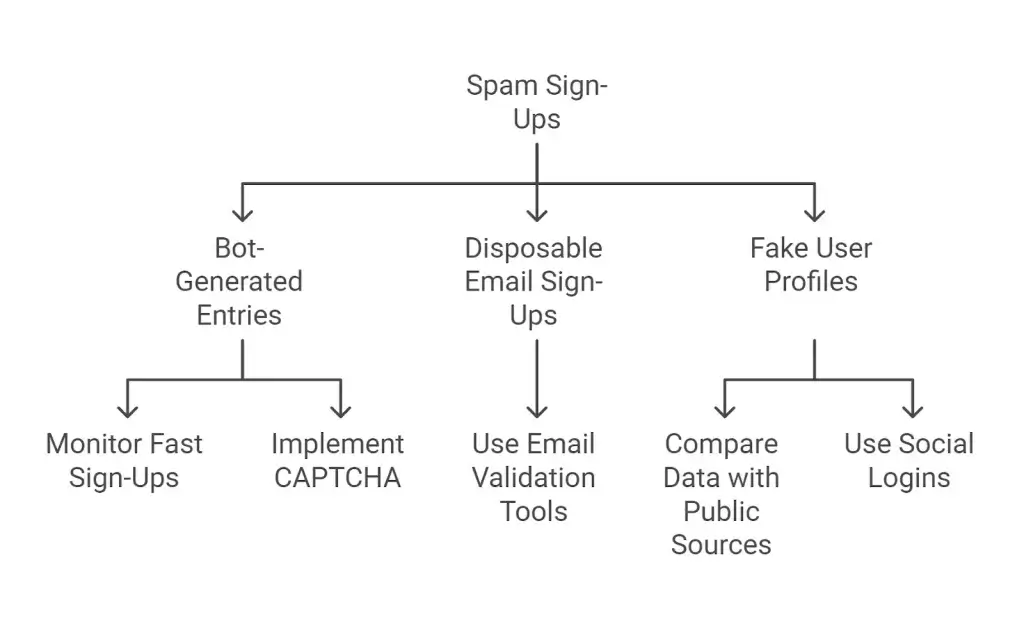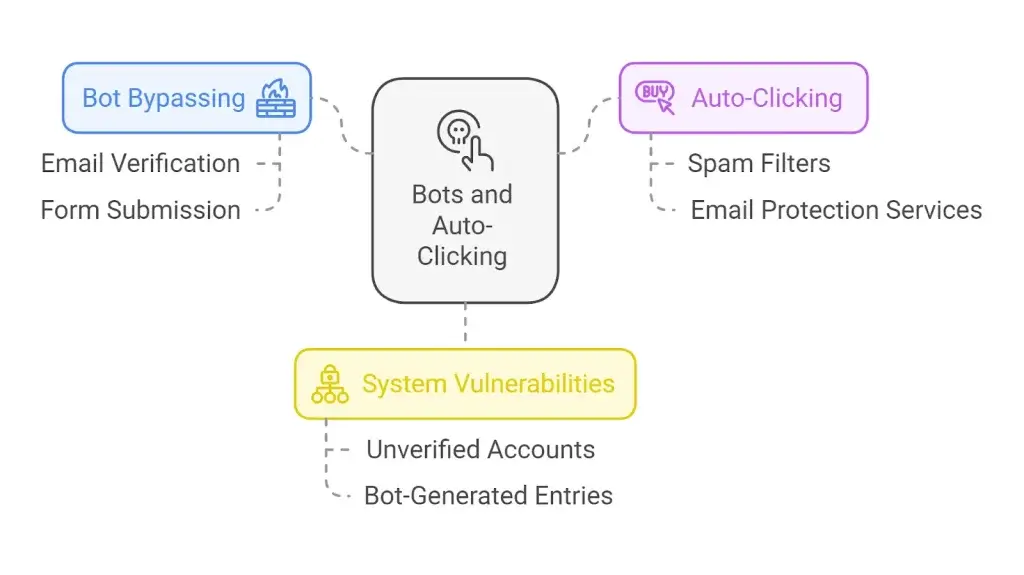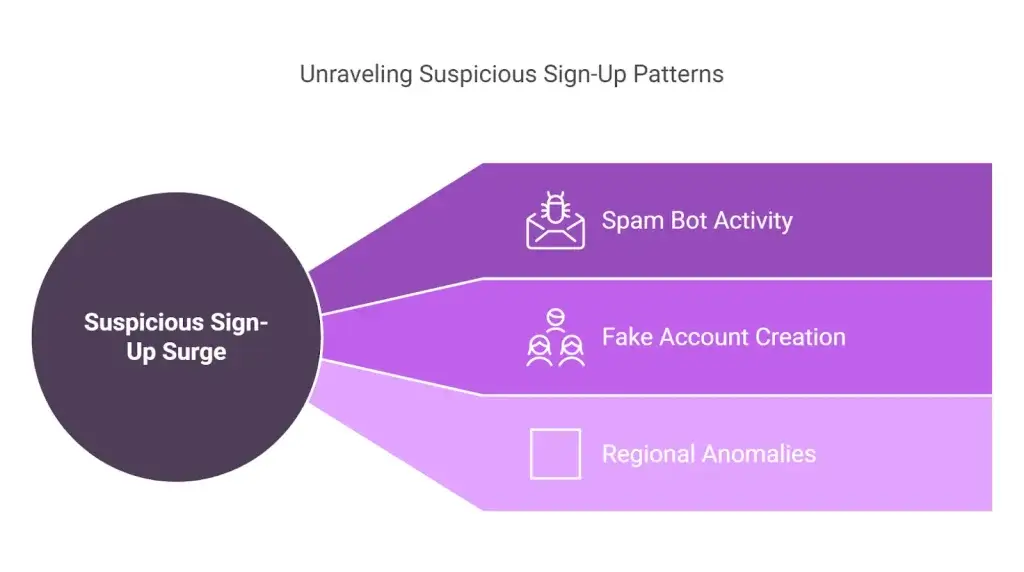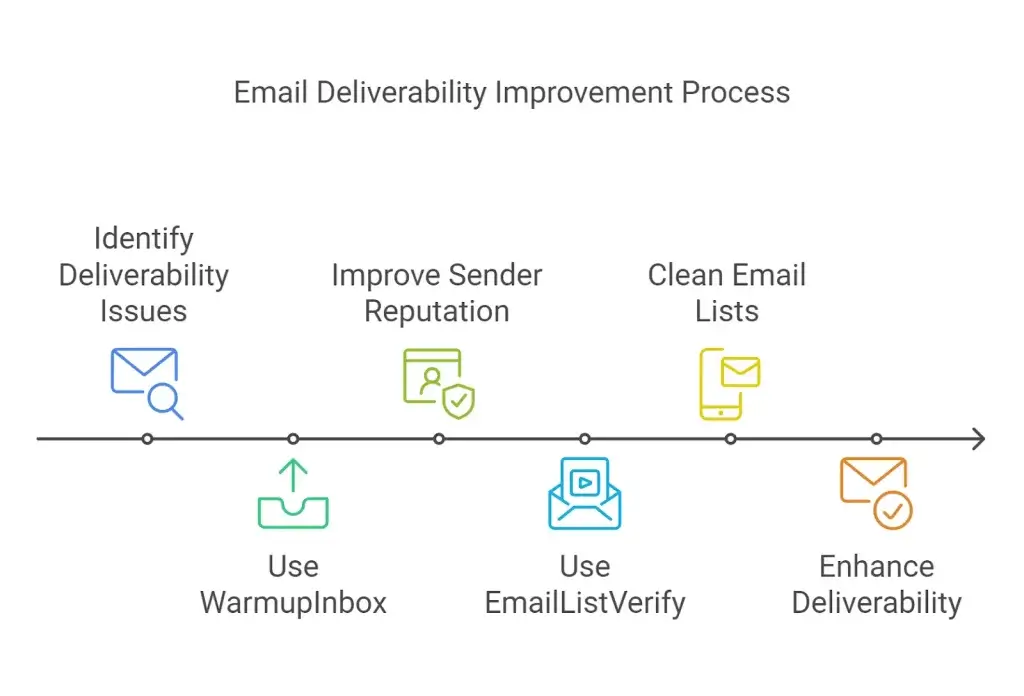
Quick links
Spam sign-ups are an ongoing problem for many businesses, and while email verification is an essential part of the solution, it’s not enough on its own. The techniques used by spammers have become increasingly sophisticated, meaning that relying solely on email verification leaves your website vulnerable to a wide variety of attacks.
In this article, we’ll explore why email verification alone can’t solve the problem, the different types of spam sign-ups, and how you can implement stronger defenses to protect your website.
The rising tide of spam sign-ups
Spam sign-ups are an unfortunate reality for websites of all sizes. With an increasing number of automated bots crawling the web, it’s becoming more challenging to keep fake sign-ups at bay. These bots are designed to exploit loopholes in your sign-up process and flood your systems with bogus data.
The most troubling aspect? Many of these bots can bypass simple email verification steps, giving them free rein to submit fake accounts. Over time, this leads to a cluttered database, false engagement metrics, and even potential security threats.
Types of fake spam sign-ups

Spam sign-ups come in a variety of forms, each with its own distinctive characteristics. Below are some of the most common forms of fake sign-ups, along with examples and ways to identify them:
1. Bot-Generated Entries
Bot-generated sign-ups are among the most common and often the hardest to detect. These entries are automated by bots that mimic human behavior, filling out forms with fake details at lightning speed. Bots can bypass simple validation checks by entering fake names, emails, and other details without hesitation.
Example: Imagine a scenario where your website receives a spike in sign-ups all at once, with thousands of registrations occurring in a short amount of time. The entries might look legitimate at first glance, but upon deeper inspection, you realize that they all come from the same IP address or are similar in structure (e.g., randomized names or email addresses like “[email protected]”).
How to Identify Them: Monitoring for unusually fast sign-ups is critical. Implementing time-based analysis tools can flag entries that are completed too quickly, suggesting they were generated by a bot rather than a human. You can also use CAPTCHA systems or honeypot fields to detect automated submissions.
2. Disposable Email Sign-Ups
Disposable or temporary email addresses are another common tactic used in spam sign-ups. These are email addresses that are often only valid for a short period, such as those generated by services like 10 Minute Mail, Guerrilla Mail, or Mailinator. Some users also opt for alternative email options to maintain privacy, though these can be misused by spammers as well. Once the time limit expires, the email address becomes useless, which makes it perfect for spammers who want to create accounts without leaving a trace.
Example: A bot might sign up using an email address from a disposable email provider, such as [email protected], to avoid detection. After using the address to confirm the sign-up, the bot no longer needs access to the email account, making it easy to discard.
How to Identify Them: Use an email validation tool to identify and filter out disposable email addresses before they even hit your database. Many of these tools maintain up-to-date lists of known disposable domains and will flag such addresses automatically.
3. Fake User Profiles
Fake user profiles are another form of spam sign-ups, where the information entered is fabricated but looks real at first glance. These profiles often include fake names, addresses, phone numbers, and job titles that are designed to appear legitimate but are ultimately meaningless.
While email verification might confirm the email address is valid, these fabricated details can often reveal themselves as fraudulent when compared against other data sources or during a deeper audit.
Example: A spam sign-up might use the name John Doe, with a fake phone number, and a made-up company name. The email address could be a legitimate one, making it seem real, but the rest of the information is clearly not valid. If you were to call the phone number or search the company name, you’d find no records.
How to Identify Them: One of the most effective ways to spot fake profiles is to compare the data entered by the user with known public sources. You can use progressive profiling, where you collect additional information about users over time, rather than all at once. This allows you to better identify inconsistencies as they arise.
Additionally, implementing social logins (e.g., logging in via Facebook or Google) can help validate the authenticity of user profiles by taking advantage of verification through external accounts.
Why email verification alone falls short
Email verification remains an important tool in preventing spam sign-ups, but relying on it exclusively leaves critical gaps. While it’s great for catching invalid email addresses, it won’t do much against more sophisticated spam tactics – and here’s why:
Bot bypassing & auto-clicking
Spambots have become increasingly sophisticated, with many designed to easily bypass basic email verification checks. These bots are often able to submit sign-up forms quickly and with enough human-like behavior to evade detection. Once the form is submitted, the next step is email verification — and this is where things get tricky.
Some email protection services and spam filters might automatically click on confirmation links in email messages, giving the appearance that the email address has been verified. This auto-clicking function, commonly used by spam bots, makes the process seem legitimate, when in reality, the “verified” account is nothing more than a bot-generated entry.
Because bots can bypass basic email checks with little effort, they leave your system vulnerable.

Complex multi-step processes
In response to the limitations of email verification, many websites have turned to multi-step sign-up processes. These processes typically involve asking users to provide more information, such as a phone number, or complete additional steps like answering security questions. While this approach can effectively slow down spammers and bots, it also introduces new challenges.
The longer and more complex the sign-up flow, the more likely it is to deter legitimate users. A complex process might include filling out several fields, completing a CAPTCHA, entering a phone number, or confirming an email. While this may block many bots, it can also frustrate real users who may abandon the process if it feels too time-consuming.
The risk here is balancing security and user experience — making the process secure enough to deter bots without turning off potential customers or subscribers. To maintain a high conversion rate while protecting against spam, businesses must refine their sign-up flows to strike the right balance, ensuring that the process remains as simple as possible without compromising security.
How to identify spam sign-ups
To effectively identify and block spam accounts, it’s essential to implement additional layers of verification that focus on behavioral analysis, patterns, and suspicious activity. By incorporating several techniques, you can more accurately pinpoint fake sign-ups and reduce the risk of spam affecting your system.
IP monitoring
Tracking the IP addresses of sign-ups is another key strategy for identifying spam accounts. Bots often operate from specific, identifiable locations, and multiple sign-ups originating from the same IP address within a short period of time is a strong indication that something suspicious is happening.
If you notice repeated sign-ups from the same IP address or location, particularly during unusual hours or spikes in traffic, this could be a bot attack or an attempt to flood your system with fake accounts.
Suspicious sign-up frequency
An unexpected surge in sign-ups, especially from regions where your business typically doesn’t operate, should always be monitored closely. A sudden spike in activity can be a sign of spam bots trying to exploit your sign-up form, either to create fake accounts or to test out various attacks.
For example, let’s say you typically see 30-40 sign-ups from U.S.-based users each day, but one day you receive 300 sign-ups, and a majority of them are from countries where you don’t normally have a user base, such as Indonesia or Ukraine. This sudden spike could suggest a spam attack where bots are attempting to submit fake accounts using various random locations.

Stronger defenses against spam
Now that you know why email verification alone isn’t enough, let’s explore stronger defenses to fight off spam sign-ups effectively:
Add a 2- or 3-step signup flow with behavior checks
Gradually collect user data (company name, job title) so spam sign-ups drop off earlier.
A multi-step sign-up flow can act as a great filter for spam while still being user-friendly. For example, you can include a step that asks for additional user details (like job title or company name), which not only enriches your data but also discourages bots.
Progressive profiling, where you gradually ask for more information as users interact with your site, can push fake sign-ups to drop off early in the process.
Time-analysis is another powerful technique for spotting automated bots. Bots are designed to fill out forms quickly, often in a matter of milliseconds, while human users typically need a few seconds to read through and complete the form.
By tracking the time it takes for users to submit a form, you can spot suspiciously fast entries that are likely to be bot-generated. If a form is filled out and submitted in less than three seconds, this should raise a red flag. While this may not always be definitive, it’s a strong indicator of a non-human submission.
Implement captchas and honeypots
reCAPTCHA is one of the most widely used and effective tools for preventing bot sign-ups, as it provides a strong layer of security while still maintaining a user-friendly experience for legitimate visitors.
The most common type of reCAPTCHA involves users selecting images that match a prompt (e.g., “Select all images with traffic lights”), or, in some cases, simply ticking a checkbox to prove they’re not a robot. It uses machine learning to analyze patterns of human interaction, which makes it very difficult for bots to bypass.
Adopt double opt-in or OTP verification
Both double opt-in and OTP verification methods effectively reduce spam sign-ups by making sure that only real, engaged users can complete the sign-up process.
Double Opt-In is a two-step verification process that requires users to not only enter their email address but also confirm it by clicking a unique link sent to their inbox. This additional step significantly reduces the chances of bots successfully completing the sign-up process. It’s particularly beneficial for preventing fake sign-ups using invalid or disposable email addresses, as bots won’t be able to access the user’s inbox to click the confirmation link.
One-Time Password (OTP) verification works by providing users with a unique, time-sensitive code via email or SMS that they must enter before completing the sign-up. Only people using a valid phone number or email address will be able to do this.
Leverage email validation tools
Automated email verification services like ZeroBounce or DeBounce can help filter out invalid, disposable, or misspelled email addresses during the sign-up process. These tools ensure that you’re collecting genuine, valid email addresses, reducing bounce rates and improving the quality of your email list.
Filter suspicious IPs and monitor sign-up frequency
Blocking multiple sign-ups from the same IP address within a short period is a quick way to stop bots in their tracks. Similarly, tracking sudden spikes in sign-up volume — particularly from regions outside your usual target areas — allows you to identify potential spam attacks before they overwhelm your system.
Use time-analysis tools
If you notice that a form is filled out almost instantly, flag it as suspicious. Humans typically take a few seconds to complete a sign-up form, so extremely fast submissions should raise a red flag for further investigation.
Add social logins or multi-factor authentication
Social Logins provide an easy and effective way to verify the authenticity of users. By allowing sign-ups through platforms like Google or Facebook, you are tapping into established, trusted sources for user profiles. These platforms perform extensive verification themselves, reducing the likelihood of fraudulent sign-ups.
Multi-Factor Authentication (MFA) takes verification one step further by requiring more than one method of authentication. For high-value accounts, implementing MFA — such as a combination of email and SMS verification — adds an additional layer of security.
Regular deliverability testing
Deliverability testing tools like WarmupInbox help improve your sender reputation by gradually increasing your email volume and interactions so your emails are seen as trustworthy by Internet Service Providers (ISPs).
EmailListVerify, on the other hand, will clean and validate email lists by identifying invalid, disposable, or risky email addresses.
If too many emails from your domain end up in spam folders, it could indicate that your list contains a high number of fake or inactive addresses, potentially linked to previous spam sign-ups.

Ongoing Monitoring with deliverability tools will help you stay ahead of any potential issues before they affect your email marketing campaigns. For example, if a significant drop in deliverability occurs after a sudden surge in sign-ups, this could point to problematic behavior from spam bots.
How to remove spam signups
Once spam sign-ups have been identified, it’s important to act quickly to prevent any further damage to your database, email campaigns, or customer engagement efforts.
- The first step is to clean your database by removing any suspicious or fraudulent entries: This involves going through the list of new sign-ups and deleting accounts that show signs of being fake, such as using disposable email addresses, invalid information, or automated entries.
- Next, block any fraudulent IP addresses that may be repeatedly attempting to submit fake sign-ups. Many email validation tools provide IP filtering features, allowing you to identify and block these sources of spam from your website or sign-up form.
- Set up a strong sign-up process is essential to prevent future spam.
- Review your sign-up logs regularly to make sure only legitimate users get through. Email List Verify can identify and flag disposable or misspelled email addresses, preventing fake sign-ups before they even enter your system.
- Implement multi-layered verification methods, like CAPTCHA or double opt-in, to catch bots before they complete the sign-up process.
Consistently using these practices will allow you to maintain a clean, high-quality user database, reduce bounce rates, and improve the overall efficiency of your email marketing campaigns.
Unexpected benefits
While it may feel like an extra task to implement strategies for removing spam sign-ups, the long-term benefits far outweigh the initial effort. Once your email list is cleaned and free of fake or inactive accounts, you’ll begin to see several unexpected benefits that enhance both your marketing performance and your brand reputation. These include:
- Better Insights & ROI: By removing fake or inactive users, you’re left with a list of engaged, real customers who are more likely to interact with your content. As a result, your marketing campaigns become more efficient, with higher open rates, click-through rates, and conversion rates. You will also be spending less on trying to reach uninterested or fake users, and more on building meaningful relationships with actual customers.
Enhanced Trust & Brand Image: Customers are more likely to trust a business that shows a commitment to security and data privacy. By implementing tools like email validation services, CAPTCHAs, and multi-step verification processes, you send a strong message that you prioritize the safety of their personal information. When customers feel secure in their interactions with your site, they are more likely to engage with your business, recommend it to others, and become loyal, long-term customers.
Join Our Monthly Newsletter
Learn how to improve email deliverability and clean your email lists with and more.


